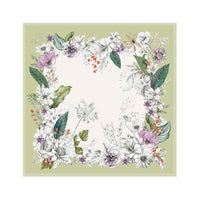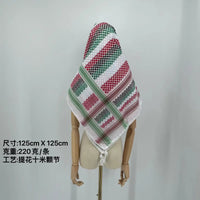I. Introduction
Where did you first notice it?
Perhaps it was in "The Martian," where Matt Damon used it to shield himself from the Martian storms. Or perhaps it was in "The Hurt Locker," where American soldiers wiped sweat from the scorching Iraqi sun. Or perhaps you saw fashionistas wearing it as a unique neck accessory on the streets of Harajuku, Tokyo.
This seemingly simple checkered scarf has a well-known name—the Shemagh (pronounced "she-mog"). It frequently appears in news, movies, games, and fashion trends, but our understanding of it often remains limited to "a cool-looking piece of fabric."
However, the Shemagh's story is far deeper and richer than you might imagine. It's not simply a piece of tactical gear or a fashion item, but a cultural totem that carries thousands of years of history, embodies the survival wisdom of desert peoples, and has been endowed with diverse meanings across cultures.
Today, let's uncover the mysteries of this scarf, from its ancient origins to its amazing practical functions, and how to integrate it into our daily lives.
Let's talk: When did you first encounter shemagh? Was it a tough-guy film, a trendy street style, or a real travelogue? Share your first impressions in the comments!
II. Tracing the Origins: Shemagh's Millennial Journey
To understand shemagh, we must first turn our gaze to its true home—the vast, scorching Arabian Desert.
Wisdom of the Desert: The Birth of Keffiyeh
Shemagh, originally known as keffiyeh (sometimes also called ghutra), originates in the Middle East. For nomadic peoples like the Bedouin, who live in desert environments year-round, a piece of keffiyeh is an essential part of life. Its iconic 110cm x 110cm size and cotton or linen blend make it an ideal choice for harsh environments: during the day, it provides shade from the scorching sun, preventing sunburn and heatstroke; when winds blow, it wraps around the head and face, effectively shielding against swirling sand and dust; and when the desert night temperatures plummet, it doubles as a warm scarf or shawl.
Name Evolution
"Keffiyeh" is its common name in the Arab world. The word "Shemagh" is believed to be derived from the Turkish "yaşmak," meaning "veil." This name became popular with the British military's activities in the Middle East. In the early 20th century, the iconic image of British officer T.E. Lawrence, known as "Lawrence of Arabia," brought the keffiyeh into Western consciousness, along with legend. Later, during World War II and subsequent military operations in the Middle East, special forces from countries like the United States and Britain discovered the immense practicality of this kerchief and began to use it as standard equipment. "Shemagh" thus became its better-known name in military and tactical circles.
The Language of Pattern and Color
The seemingly random patterns on the shemagh actually contain rich cultural information.
• The Black and White Keffiyeh: This is the most familiar pattern. Its classic fishnet pattern symbolizes the Palestinian fishermen's connection to the sea, while the bold lines alongside it represent the trade routes connecting the Mediterranean and the Persian Gulf. Since the mid-20th century, the black and white keffiyeh has become a strong symbol of Palestinian nationalism and identity.
• The Red and White Keffiyeh (Shemagh): This pattern is common in Jordan and some Gulf States. It also has deep cultural roots. Its design is said to represent ears of wheat, symbolizing harvest and abundance. In Jordan, it is closely linked to the traditions of the Hashemite Kingdom.
• Other Colors: Today, to meet tactical and fashion needs, the shemagh has evolved into a variety of colors, such as wolf brown, military green, and sand, primarily for enhanced camouflage.
From traditional to global, the shemagh has made a remarkable transformation. It's not only a traditional headdress for Middle Eastern men, but has also become a popular choice for military personnel, outdoor enthusiasts, survivalists, punks, and fashion icons worldwide.
III. Functionality First: Why is the shemagh the ultimate survival tool?
If history and culture give the shemagh its soul, then its unparalleled practicality is its core asset for its global popularity. In a crucial moment, a small shemagh can become a mobile "survival toolkit."
Basic Protection:
• Sun Protection: The most basic function is that the loose cotton fabric effectively blocks UV rays.
• Wind and Sand Protection: Wrapping around the mouth and nose, it instantly forms a highly effective physical filter.
• Warmth: The pure cotton material offers excellent warmth when dry, making it suitable for use as a scarf or hat. • Mosquito Repellent: In the jungle or outdoors, you can cover your head and neck to prevent mosquito bites.
• Camouflage: Shemagh in colors like sand and military green is an excellent camouflage tool, helping you blend in.
Outdoor First Aid:
• Bandage: Clean shemagh can be torn into strips and used to bandage wounds.
• Sling: If you have a broken or dislocated arm, you can fold it into a triangular bandage to create a makeshift sling to immobilize the injury.
• Splint: Combined with a hard object like a branch, it can be used to immobilize a broken limb.
• Compression Hemostasis: In emergencies, it can be used as a tourniquet (note: use with caution by non-professionals as it may cause tissue necrosis).
Survival Skills:
• Water Filtering: While it cannot sterilize, it can filter large particles of impurities such as mud, sand, and weeds from muddy water, preparing it for subsequent purification.
• Dew Collection: Spread it on plants at night to collect a small amount of precious drinking dew in the morning. • Fire Starter: Dry, pure cotton shemagh, torn into small pieces or strips, makes excellent tinder.
• Rope Making: Roll it into a long strip or tear it apart to create a short, emergency rope.
• Simple Backpack: Tie the four corners together to make a makeshift bag and carry items.
• Signal Flag: A brightly colored flag can be used as a distress signal.
Brainstorming Time: Besides the ones mentioned above, what other creative uses can you think of for a shemagh? Perhaps using it for fishing? Or making a simple hammock? Share your ideas in the comments!
IV. How to Wear: Three Classic Ways from Beginner to Expert
After learning so much, are you itching to get your shemagh and wear it? Here are three of the most common and practical ways to wear it.
The Traditional Head Wrap
This is the most traditional way to wear a shemagh in the Middle East, offering the most comprehensive protection.
1. Unfold the shemagh completely and fold it diagonally into a large triangle. 2. Place the long side of the triangle on your forehead, with its edge between your eyebrows and hairline.
3. Pull the shorter right corner (approximately chin length) from below your chin to the left side, and secure it with your left hand next to your cheek.
4. Grab the longer left corner and stretch it across the front of your face, completely covering your mouth and nose.
5. Continue wrapping this long corner around the back of your head, over the crown of your head, and finally in front of your right shoulder.
6. Secure the ends with a secure knot at the back or side of your head. You can adjust the tightness of the face covering as needed.
The Tactical Mask Method
This method is quick and easy, and is popular among outdoor and military enthusiasts.
1. Fold the shemagh into a triangle and drape it over your shoulders and neck, with the top of the triangle facing down and hanging in front of your chest.
2. Cross the left and right corners at the back of your neck.
3. Bring them back together in front of your chest. 4. Tie the two corners together under the triangular scarf on your chest to secure.
5. Finally, pull the triangular scarf up over your chest to cover your mouth and nose.
The Casual Neck Scarf
This is the simplest way to wear the shemagh for everyday wear, adding a touch of flair to your outfit.
1. Grasp the center of the shemagh and let it hang naturally.
2. Loosely wrap it around your neck.
3. Alternatively, fold it like a regular scarf, wrap it around your neck, and thread the tail through the loop.
Try it yourself! The description may seem a bit complex, so try searching for a video tutorial online and following along. You'll find it's much simpler than you think.
V. Conclusion: A scarf with a story
From a Bedouin necessity to a Palestinian national symbol; from a tactical piece of special forces equipment to a fashion favorite, the shemagh, with its millennia of history, teaches us that the value of an object goes far beyond its physical form. It's a living history, documenting the culture and evolution of a region. It's a superb toolkit, showcasing humanity's wisdom in surviving the harsh natural world. It's also a multifaceted lens, reflecting the intersection and collision of culture, politics, and fashion in the age of globalization.
So, next time you see this scarf, I hope you'll see not just its pattern and color, but also the profound and captivating story behind it.
Final interaction: After reading this article, have you taken a new look at this small scarf? Are you planning to buy your first Shemagh, or do you already have a collection and unique wearing experiences? Leave a comment below and share your Shemagh story with us!















